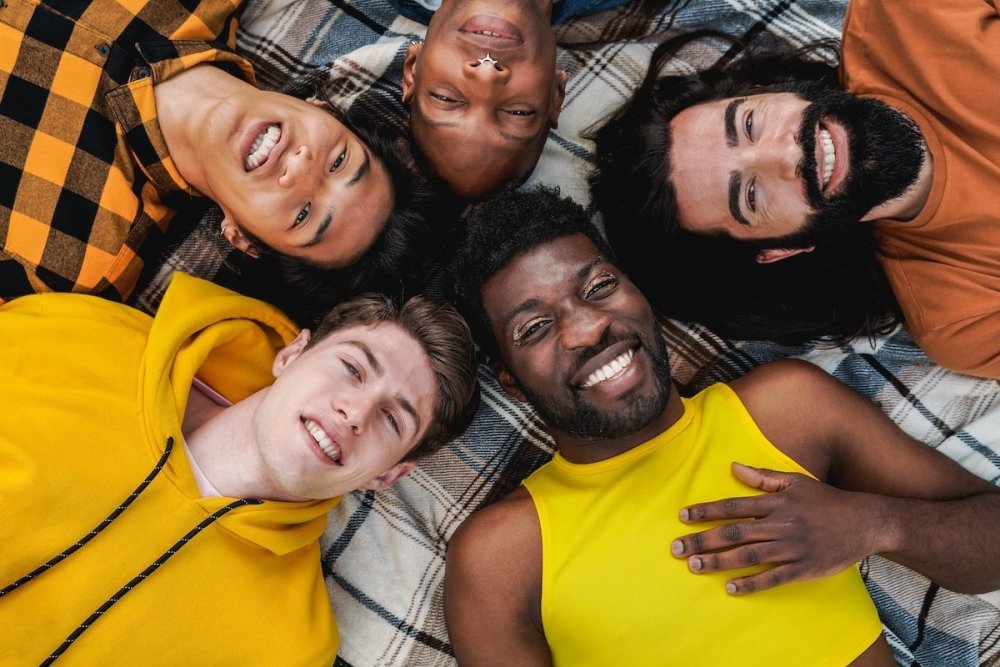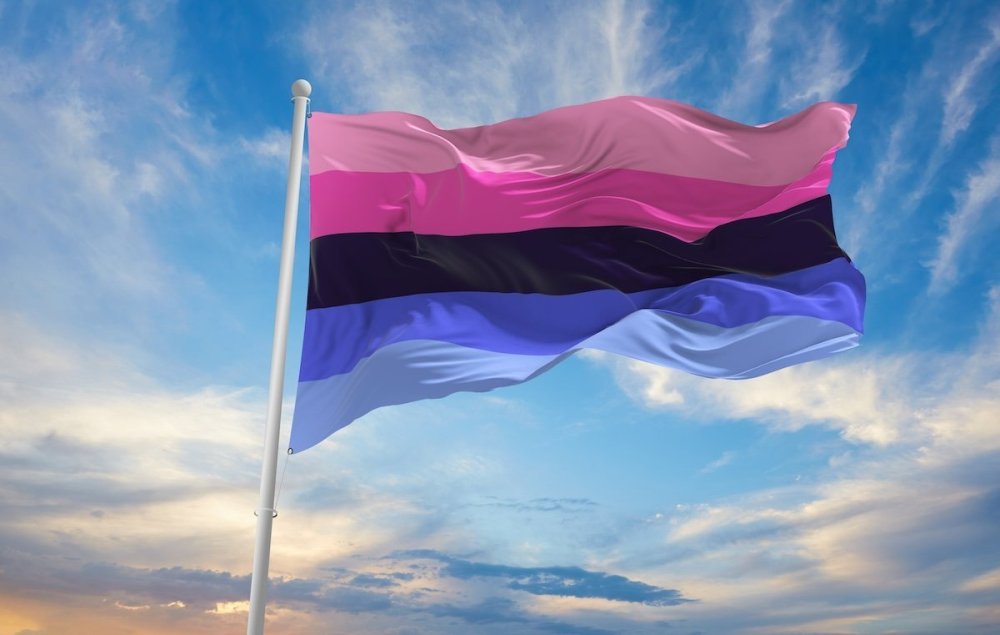For those unfamiliar with the term, omnisexuality can be confusing. Sonia Vadlamani breaks down the meaning of omnisexuality, how it plays out in relationships, and debunks common myths surrounding it, including how it differs from pansexuality.
Omnisexuality is a form of multisexuality or plurisexuality where individuals are attracted to people of all genders, including male, female, and nonbinary people. It’s a term recognized within the Lesbian, Gay, Bisexual, Transgender, Queer (LGBTQ+) community, alongside other non-conforming and non-heteronormative gender identities.
However, this does not mean that omnisexual people experience attraction to every person they meet. Indeed, like with any other non-monosexual orientations, omnisexual attraction is unique to each individual, and its understanding continues to evolve over time.

Omnisexuals can be attracted to all genders
People who identify as omnisexual often face unique social challenges, as well as distinct issues regarding relationships and health, which require specialized support and care. A deeper understanding and finding the right support network are essential for fostering a sense of belonging and acceptance.
Omnisexual vs pansexual: how they differ
According to LGBTQIA Resource Center, both omnisexual and pansexual people experience affection, romantic attraction or sexual desire toward individuals of all genders and sexual orientations. However, while their attraction is inclusive, there are some key differences regarding how they experience and express them.
“Omnisexual people may have identified previously with a different sexual orientation before they had a chance to fully understand what omnisexuality is.”
Gender blindness is one of the defining aspects of pansexuality. Pansexual individuals do not consider gender a relevant factor in their attraction to others. In contrast, omnisexual people, while being open to people of all genders, are aware of gender in their attraction. Indeed, omnisexual people can also experience distinct emotional and physical preferences for people of different genders.
For instance, here’s what statements of omnisexual vs. pansexual individuals may sound like:
- Pansexual: “Gender doesn’t influence me when it comes to dating. I’m attracted to people regardless of their gender.”
- Omnisexual: “I’m attracted to people of all genders, although I mostly tend to date men.”
Dispelling myths about omnisexual people
Like many other multisexual identities, omnisexuality frequently faces misunderstanding and mislabeling. Indeed, it’s easier to find information about some multisexual categories like bisexuality or pansexuality, because of which there may be bias or confusion regarding what separates omnisexual vs pansexual or other plurisexual orientations. People may not understand what is omnisexuality and not much literature can be found on omnisexuality to help the matters either.
Here are some prevalent myths about the meaning of omnisexual orientation which we will aim to debunk:
Myth 1: Omnisexuality is a recent trend
Contrary to the popular belief, omnisexuality is not a new phenomenon – it has always existed but is only gaining recognition and understanding in recent years.
 Unlike pansexual people, omnisexuals are aware of gender in their attraction
Unlike pansexual people, omnisexuals are aware of gender in their attraction
In fact, the term “omnisexuality” was first mentioned by beat poet Lawrence Lipton in the nonfictional classic The Holy Barbarians in 1959, and later described as “a state of attraction to all sexes” in the text Sexual Choices: An Introduction to Human Sexuality by Gilbert D Nass in 1984.
However, it’s only in recent years that omnisexuality has been discussed more openly, thanks to the rise of the internet and social media.
Myth 2: Omnisexual people are easily attracted to anyone
This myth, like the other ones, arises mostly from lack of understanding about omnisexuality. While omnisexual individuals are attracted to people of all genders, they still have distinct preferences and standards when it comes to forming emotional, romantic, or sexual connections.
Myth 3: Omnisexual people are uncertain about their sexuality
Several omnisexual people may have identified previously with a different sexual orientation before they had a chance to fully understand what omnisexuality is. This doesn’t mean they are indecisive or confused – it simply indicates their journey toward self-discovery and coming to terms with their sexual identity with time.
“Both omnisexual and pansexual people experience romantic attraction or sexual desire toward individuals of all genders and sexual orientations.”
Indeed, omnisexuality is a distinct and valid sexual identity. Omnisexuality refers to the capacity to feel attraction for all genders while acknowledging individual preferences. Therefore, being in a heterosexual relationship, for instance, doesn't make them confused or uncertain – they’re simply experiencing attraction within the extensive spectrum of their sexuality.
Omnisexuality doesn't equal polyamorous
Myth 4: Omnisexual people are polyamorous
In contrast, omnisexual individuals have varied needs and distinct preferences, just like people of any other sexual orientation. They can choose monogamous relationships, open relationships, or practice ethical non-monogamy – each of which is a valid choice. Ultimately, relationship dynamics are a matter of personal preference for any individual, regardless of their orientation.
How omnisexuality works in a relationship
Identity invalidation – wherein others ignore, deny, or refuse to accept one’s sexual identity – is a common challenge faced by bisexual individuals and, by extension, others on the multisexuality spectrum, including omnisexual people. This lack of recognition can have a negative impact on their mental health and overall well-being.
While the meaning of omnisexual orientation pertains to attraction to people of all genders, a partner’s gender can still influence one’s romantic dynamics and relationships. Thanks to social media, more omnisexual individuals have been inspired to share their stories and experiences, helping to raise awareness and expand understanding of the multisexual spectrum.
“While the meaning of omnisexual orientation pertains to attraction to people of all genders, a partner’s gender can still influence one’s romantic dynamics.”
However, your friends, family members, work associates, and partner may not be familiar with the meaning of omnisexuality. Taking the time to explain your identity and preferences is the most effective way to foster understanding, build trust, strengthen relationships, and create a more supportive environment for yourself and others like you. Open discussions about omnisexuality in relationships are key to breaking misconceptions and promoting acceptance.
The omnisexual flag
The omnisexual flag serves as a powerful symbol of pride, visibility, and the recognition of omnisexuality as a valid and distinct sexual orientation. The flag features five horizontal stripes of equal width, each representing different aspects of the identity:
- Light pink and light blue to denote the gender spectrum.
- Dark pink to represent femininity and attraction to women.
- Dark blue to represent masculinity and attraction to men.
- Purple to symbolize attraction to people of all genders, including non-binary people, gender-fluid people, and other gender-diverse individuals.
Takeaway: Understanding what is omnisexuality
If someone you know identifies as an omnisexual, you can be an ally – not just to them but also to others on the multisexual spectrum – by joining support groups, advocating for LGBTQ+ rights, and supporting inclusive policies. Awareness begins with self-education.
So, start by educating yourself through various resources to develop a well-rounded understanding of omnisexuality. And – if you identify as omnisexual – sharing personal experiences and explaining how omnisexuality has shaped your relationships can help others view it as a valid orientation. This approach also helps foster meaningful conversations around multisexual orientations, promoting a broader acceptance. •
Images: shutterstock/Lomb, shutterstock/Maxim Studio, shutterstock/AlvaroMP, shutterstock/NuvaFrames
happiness.com | The fine art of being: learn, practise, share
Are you a happiness.com member? Sign up for free now to:
■ enjoy our happiness magazine with practical life tips
■ share and support others in our happiness forum
Written by Sonia Vadlamani
 Fitness and healthy food blogger, food photographer and stylist, travel-addict and future self journaler. Sonia loves to write and has resolved to dedicate her life to revealing how easy and important it is to be happier, stronger and fitter each day. Follow her daily pursuits at FitFoodieDiary or on Instagram.
Fitness and healthy food blogger, food photographer and stylist, travel-addict and future self journaler. Sonia loves to write and has resolved to dedicate her life to revealing how easy and important it is to be happier, stronger and fitter each day. Follow her daily pursuits at FitFoodieDiary or on Instagram.



Join the conversation
You are posting as a guest. If you have an account, sign in now to post with your account.
There are no comments to display.